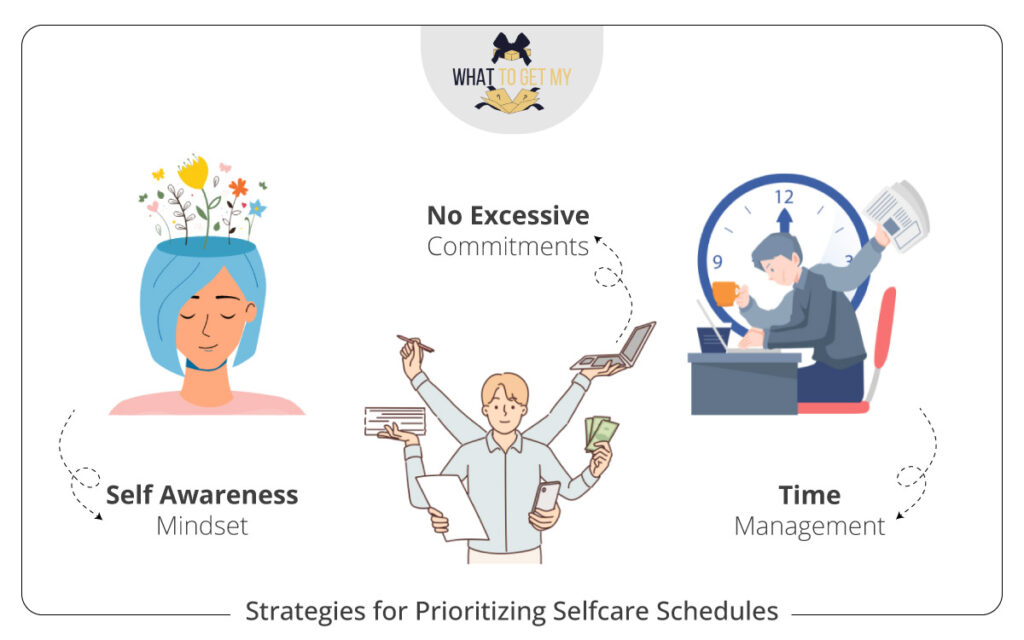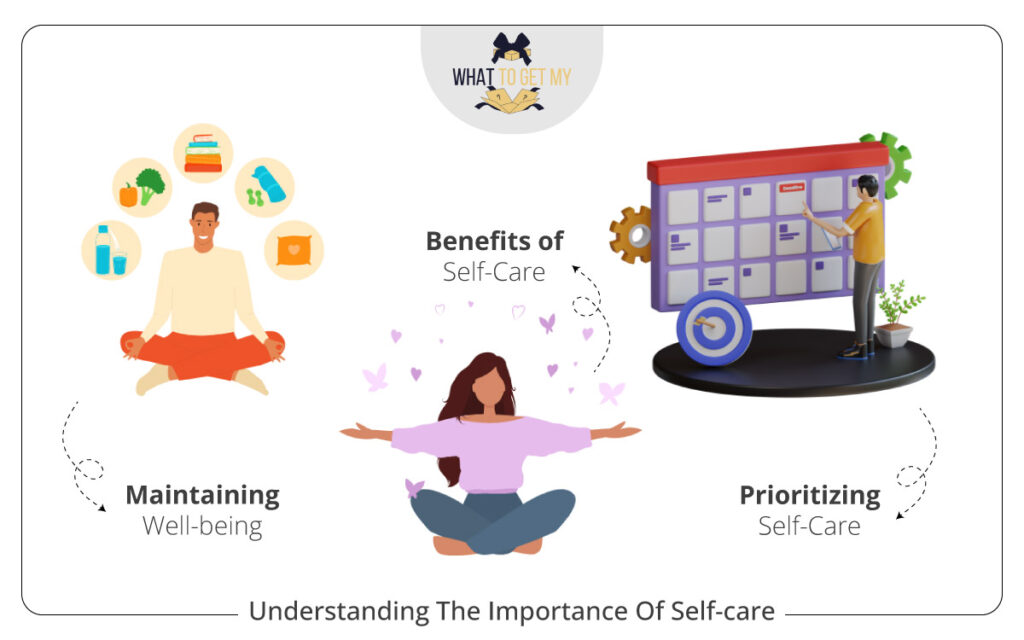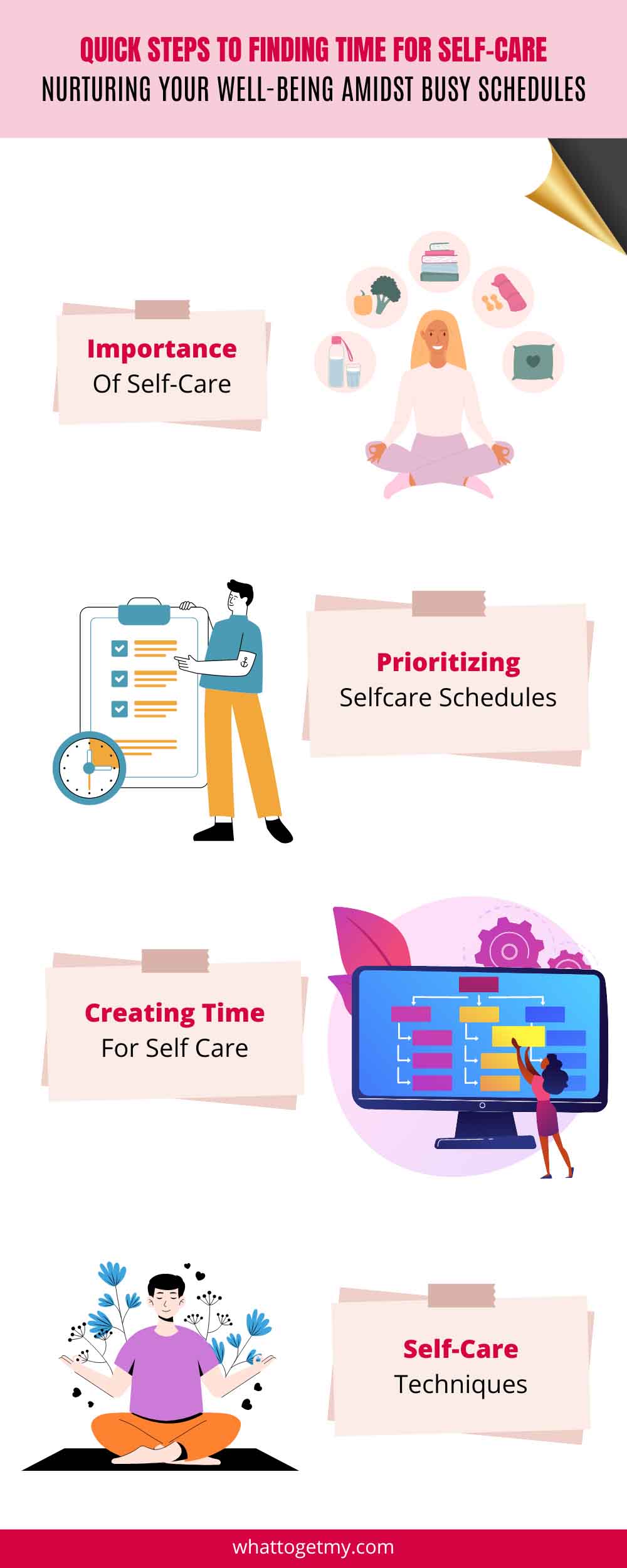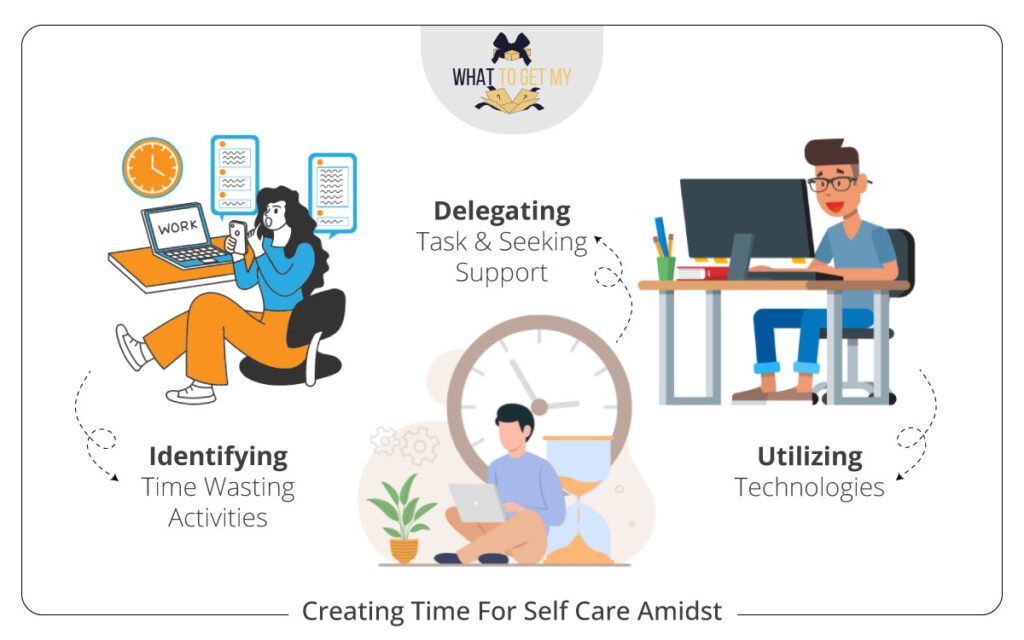5 Quick Steps to Finding Time for Self-Care: Nuturing Your Well-Being Amidst Busy Schedules in 2023
-
It is easy to forget yourself in the throes of a fast-paced and demanding schedule.
-
In the following sections, we will explore various aspects of self-care and provide actionable tips and techniques for incorporating self-care into your busy schedule.
-
Creating time for self-care amidst a busy life can be challenging in our busy modern lives.
-
Prioritizing self-care in a busy schedule requires a mindset shift. Recognize that self-care is not a luxury but a necessity for overall well-being.
Firstly, self-care helps to reduce stress levels and prevents burnout, allowing us to recharge and maintain our energy and enthusiasm.
I. Introduction
It is easy to forget yourself in the throes of a fast-paced and demanding schedule. As a result, finding time for self-care has become increasingly essential. As we juggle numerous responsibilities and commitments, neglecting our well-being is easy. However, prioritizing self-care is crucial for maintaining a healthy mind, body, and spirit. This article will delve into “Finding Time for Self-Care: Nurturing Your Well-Being Amidst Busy Schedules” and provide valuable insights and strategies to help you carve out time for self-care, even amid hectic routines.
Self-care is not a luxury but a necessity for our overall well-being. It encompasses activities and practices that promote self-nurturing, relaxation, and rejuvenation. The main focus of this article is to guide you on how to find time for self-care, despite the constraints of a busy schedule. By understanding the importance of self-care and implementing practical strategies, you can enhance your physical and mental health, improve productivity, and foster a greater sense of balance and fulfillment. Here are some self-care tips for busy schedules: take a few minutes to meditate daily, walk during your lunch break, or read a book before bed.
A. Preview
In the following sections, we will explore various aspects of self-care and provide actionable tips and techniques for incorporating self-care into your busy schedule. We will begin by understanding self- care’s significance and its challenges in today’s fast-paced world. Next, we will delve into strategies for prioritizing self-care, including effective time management techniques and setting boundaries. We will also discuss creating dedicated time for self-care amidst a hectic life and suggest self-care techniques tailored to busy individuals. Lastly, we will address common barriers to self-care and provide solutions to overcome them. By the end of this article, you will understand how to nurture your well-being amidst your busy schedule and embrace self-care as an integral part of your life.

II. Understanding the Importance of Self-Care
A. Self-care and its role in maintaining well-being
Self-care encompasses intentional activities and practices that promote physical, mental, and emotional well-being. It involves taking deliberate steps to nurture, care for, maintain balance, reduce stress, and enhance the quality of life. Self-care is a vital component of self-preservation and optimal health. Managing self-care with a busy schedule is essential for your overall well-being.
B. The challenges of prioritizing self-care in busy schedules
Creating time for self-care amidst a busy life can be challenging in our busy modern lives. The demands in our busy modern lives of work, family, social obligations, and other responsibilities often leave little room for personal well-being. We may feel guilty or selfish for taking time for ourselves when there are so many other things to be done. Additionally, societal expectations and the constant pressure to be productive can create a culture of neglecting self-care in favor of constant busyness.

C. The benefits of incorporating self-care practices:
Prioritizing self-care and incorporating it into our busy schedules offers numerous benefits. Firstly, self-care helps to reduce stress levels and prevents burnout, allowing us to recharge and maintain our energy and enthusiasm. It improves our mental health by reducing anxiety, enhancing self-esteem, and fostering a positive mindset. Self-care also enhances physical well-being by promoting better sleep, boosting immunity, and reducing the risk of chronic illnesses. Furthermore, taking time for self-care allows us to connect with ourselves, cultivate self-awareness, and strengthen our relationship with our own needs and desires. Ultimately, incorporating self-care practices enhances our ability to show up fully in all areas of life, improving our productivity, relationships, and overall satisfaction. Prioritizing self-care in a busy life can be challenging but essential for overall well-being.
Balancing self-care and a busy schedule is a delicate yet essential dance to maintain your overall well-being amidst the demands of a fast-paced life. By understanding the importance of self-care and its benefits, we can start overcoming and prioritizing the challenges in our busy schedules. In the following sections, we will explore practical strategies for prioritizing self-care and finding the time to nurture our well-being amidst the demands of daily life.
III. Strategies for Prioritizing Self-Care in Busy Schedules
A. Emphasize the need for mindset shift and self-awareness
Prioritizing self-care in a busy schedule requires a mindset shift. Recognize that self-care is not a luxury but a necessity for overall well-being. Cultivate self-awareness by understanding your needs, limitations, and the signs of burnout. Acknowledge that taking care of yourself is essential for showing up fully in all areas of your life. There are many effective self-care strategies for busy individuals. Still, some of the most common include: setting boundaries, delegating tasks, prioritizing sleep, scheduling self-care into your day, and finding activities you enjoy.
B. Discuss effective time management techniques
Time management is crucial when balancing a busy schedule and incorporating self-care. Consider the following strategies:
– Prioritize self-care: Treat self-care as an essential appointment and schedule it into your calendar.
– Break tasks into manageable chunks: Divide larger tasks into smaller, more manageable ones to prevent feeling overwhelmed.
– Set realistic goals: Avoid overloading your to-do list and set achievable goals to prevent time pressure and stress.
– Delegate and outsource: Identify tasks that can be delegated or outsourced to create more time for self-care.
C. Tips for setting boundaries and saying no to excessive commitments
Setting boundaries and saying no to excessive commitments is crucial for creating space for self-care. Consider the following tips:
– Evaluate your priorities: Determine what truly matters to you and align your commitments accordingly.
– Learn to say no: Practice saying no to commitments that do not align with your priorities or overwhelm your schedule.
– Delegate responsibilities: Share responsibilities with others and ask for support when needed.
– Communicate your boundaries: Communicate your boundaries and limitations to others, expressing your need for self-care.
D. Integrating self-care into daily routines and habits
Incorporating self-care into your daily routines and habits can make prioritizing easier. Here are some quick self-care routines for busy people that you can try:
– Identify small self-care activities: Find quick and simple self-care practices that seamlessly integrate into your day.
– Create rituals: Establish regular self-care rituals, such as starting your day with meditation or ending it with a relaxing bath.
– Use downtime effectively: Instead of mindlessly scrolling through social media during breaks, engage in activities that replenish your energy.
By implementing these strategies for prioritizing self-care, you can create a more balanced and fulfilling life, even amidst a busy schedule. In the next section, we will explore how to carve out dedicated time for self-care amidst the demands of a hectic life.

IV. Creating Time for Self-Care Amidst a Busy Life
A. Identifying time-wasting activities and minimizing them
Making self-care a priority in a busy world is not always easy To make more time for self-care, it’s essential to identify and minimize time-wasting activities. Reflect on how you spend your time and pinpoint activities that don’t contribute significantly to your well-being or productivity. Examples may include excessive social media scrolling, watching excessive TV, or engaging in unproductive conversations. By consciously reducing or eliminating these time-wasting activities, you can free up valuable time for self-care.
B. Utilizing technology and productivity tools to optimize time
In today’s digital age, technology can be both a blessing and a curse when it comes to time management. To stay organized and focused, utilize productivity tools such as calendars, task management apps, and timers. Set reminders for self-care activities, schedule dedicated self-care time, and use apps that provide guided meditations or relaxation exercises. By harnessing the power of technology, you can optimize your time and ensure that self-care becomes a consistent part of your routine.
C. Delegating tasks and seeking support from others
You must recognize that you don’t have to do everything alone. Delegating tasks and seeking support from others can create more time for self-care. Identify tasks that can be outsourced or shared with family, friends, or colleagues. Delegate household chores, childcare responsibilities, or work tasks whenever possible. By redistributing the workload and sharing responsibilities, you can free up time for self-care and alleviate some of the stress associated with a busy life.
D. Finding moments of self-care in a hectic schedule
Even in the busiest of schedules, there are opportunities to find moments of self-care. Look for pockets of time throughout your day to engage in self-care practices. This could be as simple as taking short stretch breaks or practicing deep breathing exercises. Find activities that bring you joy and relaxation, such as reading a few pages of a book during lunch breaks, walking in nature, or enjoying a mindful cup of tea in the morning. By being mindful and intentional, you can identify and seize these moments of self-care amidst the chaos of a hectic schedule.
By identifying time-wasting activities, utilizing technology and productivity tools, delegating tasks, and finding moments of self-care within your busy life, you can create more time and space for self-care. The following section will explore specific self-care techniques and practices well-suited for busy individuals.
The projected revenue for the Personal Care industry is estimated to reach a staggering US$205.50 billion by the year 2023, according to Statista.
V. Self-Care Techniques for Busy Individuals
A. The importance of self-care practices tailored to individual preferences
Self-care techniques for busy professionals are essential for maintaining a healthy work-life balance. Self-care is a highly personal journey, and finding practices that resonate with your individual preferences and needs is essential. Recognize that there is no one-size-fits-all approach to self-care. What works for one person may only work for one person. It’s crucial to prioritize self-care activities that genuinely bring you joy, relaxation, and a sense of rejuvenation. By tailoring your self-care practices to align with your preferences, you increase the likelihood of consistently engaging in them and reaping their benefits.
B. Explore various self-care activities and their benefits
There is a wide range of self-care activities that you can incorporate into your busy schedule. Explore different options and discover what resonates with you. Some popular self-care activities include:
– Mindfulness and meditation: Cultivating present-moment awareness can reduce stress, enhance focus, and promote mental well-being.
– Physical exercise: Regular physical activity boosts mood, improves physical health, and increases energy levels.
– Creative pursuits: Activities such as painting, writing, or playing a musical instrument can provide a sense of fulfillment and allow self-expression.
– Social connections: Carving out time for meaningful interactions with loved ones can nurture relationships and provide emotional support.
– Relaxation techniques: Deep breathing exercises, relaxing baths, or yoga can help reduce stress and promote relaxation.
C. Suggest efficient and practical self-care strategies for busy schedules
Recognizing the time constraints of busy professionals, here are some efficient and practical self-care strategies tailored to their needs:
– Micro self-care: Incorporate small moments of self-care throughout the day. This can include taking short breaks to stretch or engage in deep breathing exercises, listening to uplifting music during your commute, or practicing gratitude before bed.
– Prioritize quality sleep: Ensure you get enough sleep by establishing a consistent bedtime routine and creating a sleep-friendly environment.
– Multitask mindfully: Combine self-care with other activities. For example, listen to an audiobook or a podcast while doing household chores or exercise while watching your favorite TV show.
– Practice self-compassion: Be kind to yourself and practice self-compassion. Accept that you can’t do it all and embrace imperfections.
By customizing your self-care practices, exploring different activities, and incorporating efficient and practical strategies into your busy schedule, you can maintain your well-being and experience the benefits of self-care. In the next section, we will address common barriers to self-care and provide solutions to help you overcome them.
Q2: I feel guilty about taking time for myself. How can I overcome this guilt and prioritize self-care without feeling selfish?
A2: Feeling guilty about taking time for yourself is a common barrier to self-care. Recognizing that self-care is not selfish but necessary for your overall well-being is essential. Start by reframing your mindset and understanding that by taking care of yourself, you can better care for others and fulfill your responsibilities. Set realistic expectations for yourself and let go of perfectionism. Communicate your needs and boundaries to others, and remind yourself that self-care is essential to maintaining balance and preventing burnout. Practice self-compassion and remind yourself that you deserve to prioritize your well-being.
VI. Overcoming Barriers to Self-Care
A. Address common obstacles to self-care and time management
Despite recognizing the importance of self-care, various barriers often prevent us from prioritizing it. Some common obstacles include:
– Perceived lack of time: Feeling overwhelmed by responsibilities and believing there is insufficient time for self-care.
– Guilt and self-imposed expectations: Feeling guilty for taking time for oneself or placing unrealistic expectations on personal productivity.
– Poor time management: Struggling to manage time and prioritize activities effectively.
– External demands and obligations: Being pulled in multiple directions by work, family, and social commitments.
– Lack of self-awareness: Failing to recognize the signs of burnout or neglecting personal well-being.

B. Provide solutions and actionable steps to overcome these barriers
– Prioritize self-care: Make a conscious decision to prioritize self-care as an essential part of your overall well-being.
– Assess and reallocate your time: Evaluate how you currently spend your time and identify opportunities to reprioritize and create space for self-care. Eliminate or minimize time-wasting activities that don’t contribute to your well-being.
– Set realistic expectations: Release the guilt associated with self-care and set realistic expectations for yourself. Understand that taking care of yourself is not selfish but necessary for overall health and productivity.
– Practice effective time management: Utilize time management techniques such as prioritizing tasks, setting boundaries, and breaking tasks into smaller, manageable chunks.
– Communicate your needs: Communicate your needs for self-care to others, including your family, friends, and colleagues. Seek support and ask for help when needed.
– Cultivate self-awareness: Develop self-awareness by recognizing the signs of burnout and prioritizing your well-being. Tune in to your body and emotions, and take proactive steps to prevent burnout.
– Adapt and adjust: Be flexible and willing to adapt your self-care practices as your schedule and circumstances change. Embrace a growth mindset and continually refine your self-care routine.
By addressing these barriers and implementing actionable steps to overcome them, you can create a sustainable self-care practice and nurture your well-being amidst the demands of a busy life. In the concluding section, we will recap the importance of self-care and encourage readers to make it a consistent part of their lives.
Frequently Asked Questions
Q1: How can I find time for self-care when my schedule is overloaded?
A1: Finding time for self-care in a busy schedule can be challenging, but it is possible with some strategic planning. Start by evaluating your current commitments and identify non-essential or time-wasting activities that can be minimized or eliminated. Prioritize self-care by scheduling it into your calendar as you would any other necessary appointment. Look for small pockets of time throughout the day for quick self-care practices, such as deep breathing exercises or a short walk. Remember, self-care doesn’t always have to be time-consuming; even a few minutes of intentional self-care can make a difference.
Q3: What practical self-care activities can I incorporate into my busy schedule?
A3: There are many practical self-care activities that you can incorporate into your busy schedule. Here are a few examples:
– Practice mindfulness or meditation for a few minutes each day.
– Take short breaks to stretch, do deep breathing exercises, or listen to calming music.
– Prioritize quality sleep by establishing a consistent bedtime routine and creating a sleep-friendly environment.
– Engage in physical exercise, even for a short walk or a quick workout.
– Find moments of joy and relaxation by engaging in hobbies or activities that please you, such as reading, painting, or listening to music.
– Connect with loved ones and nurture your relationships, even through a phone call or a video chat.
Remember, self-care activities should be tailored to your preferences and needs. Experiment with different activities and find what resonates with you the most.
VII. Conclusion
A. The importance of self-care amidst busy schedules
In today’s fast-paced and demanding world, self-care is more important than ever. It is not a luxury or a selfish act but a vital component of maintaining our well-being. By prioritizing self-care amidst our busy schedules, we can reduce stress, prevent burnout, enhance our mental and physical health, and improve our overall quality of life.
B. Prioritize your well-being and implement self-care practices
As we conclude this article, I want to emphasize the importance of prioritizing your well-being and implementing self-care practices. Remember that self-care should not be squeezed in when you have extra time; it should be a non-negotiable part of your routine. By valuing and investing in your well-being, you enhance your life and improve your ability to show up for others and fulfill your responsibilities.
C. Critical takeaways from the article
Throughout this article, we have explored various strategies and techniques for finding time for self-care amidst busy schedules. Here are the key takeaways:
– Self-care is essential for maintaining well-being and preventing burnout.
– Prioritize self-awareness and cultivate a mindset shift towards the importance of self-care.
– Utilize effective time management techniques and delegate tasks to create space for self-care.
– Identify self-care activities that align with your preferences and incorporate them into your daily routines.
– Overcome barriers by reassessing your time, setting realistic expectations, and communicating your needs.
– Customize your self-care practices to suit your individual needs and find moments of self-care even in a hectic schedule.
Remember, self-care is an ongoing journey that requires intention, consistency, and adaptability. By prioritizing self-care and integrating it into your life, you invest in your well-being and nurture a healthier, more balanced, and fulfilling lifestyle.
As you progress, please reflect on the strategies and techniques shared in this article and choose the ones that resonate with you. Take small steps, be patient with yourself, and celebrate the progress you make along the way. Remember, you deserve to prioritize your well-being and make self-care a non-negotiable part of your life.
02 HOURS 14 MINUTES
ESTIMATED TIME DESIGNING AND UPLOADING THIS ARTICLE
08 HOURS 34 MINUTES
ESTIMATED TIME RESEARCHING AND WRITING THIS ARTICLE
LOOKING FOR MORE GIFTS?
Try our AMAZING GIFT FINDER TOOL! Find GIFTS with 1 CLICK!
LOOKING FOR MORE GIFTS?
Try our AMAZING GIFT FINDER TOOL! Find GIFTS with 1 CLICK!
LOOKING FOR MORE GIFTS?
Try our AMAZING GIFT FINDER TOOL! Find GIFTS with 1 CLICK!
You Might Also Like



